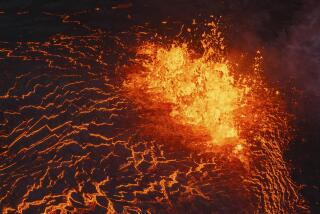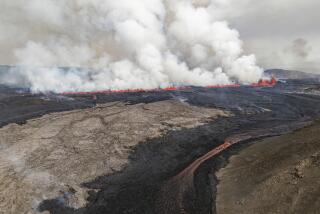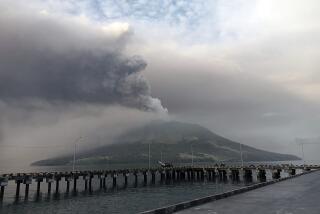Volcanic ash an air-traffic stopper but not a climate or health hazard
The massive billow of dust from an Icelandic volcano is pretty much a run-of-the-mill ash cloud that is a concern primarily because of its location and the prevailing winds, which are forcing it into transatlantic air lanes and over European airports, experts said Thursday.
Except for the immediate vicinity of the volcano, the eruption is unlikely to produce long-term climatic or health effects unless there is a sharp change in the amount of material emitted, researchers said.
Volcanic eruptions “are such a complicated natural phenomenon that almost every one is unique . . . and the amount of ash produced during a given eruption or the length of the eruption is really something that we can’t predict,” said Earth scientist Olivier Bachmann of the University of Washington.
The average volcanic eruption lasts seven weeks, said volcanologist Rick Wunderman of the Smithsonian Institution’s Global Volcanism Program. But the range is 20 minutes to 700 years.
“Only time will tell as to the size of this plume,” said volcanologist Bill Burton of the U.S. Geological Survey. Icelandic eruptions can last for only a few days or can go on for months or years. “We’re still gathering information and trying to get on top of this.”
Researchers can’t predict how long the plume might pose a potential problem for air travel. Much depends on wind patterns, weather and the possibility of nearby eruptions.
Iceland itself was formed by volcanic activity. It sits on the mid-ocean ridge where two tectonic plates are pulling apart, allowing magma to rise to the surface. Moreover, the island lies atop what scientists call a hot spot, where even greater quantities of magma are produced. The Hawaii islands were also produced by a hot spot.
There are two general types of volcanoes: those that produce lava flows (such as the ones in Hawaii) and those that produce eruptions of steam and ash.
The Icelandic eruptions started last month with lava flowing from side fissures, so-called fire fountains, that drew spectators.
After a few days, however, the eruption site shifted to the broad crater of a massive shield volcano -- which looks quite different from pointed-peak volcanoes such as Mt. Shasta -- that lies beneath the Eyjafjallajokull glacier. That is when clouds of ash began to spew.
The primary difference between the two types of volcano is the amount of water present underground and the gases dissolved in the magma, or liquid rock. If there is little gas or water, the magma will flow out almost sedately. But if there is a lot of water, the eruption will be explosive, and large quantities of ash will be ejected.
Although researchers call the material ash, it isn’t the kind that most people associate with the word. Rather, it is very fine-grained rock and glass, most of it ranging in size from about one-twelfth of an inch in diameter down to 1/25,000th of an inch.
Anything larger quickly settles to the ground near the volcano. But the finer particles can reach the upper atmosphere and circulate for months.
Because the particles are formed by explosive stress fractures, they tend to have very sharp edges. The particles can damage the airways of humans and animals if inhaled, and can shut down airliner engines by restricting air flow and damaging internal parts. The material can also scour the surfaces of planes.
In 1989, for example, a Boeing 747 operated by KLM Royal Dutch Airlines flew into an ash cloud ejected by the Mt. Redoubt volcano in Alaska and all its engines went out. The plane dropped from 25,000 feet to 12,000 feet before pilots could get the engines restarted. The USGS says about 100 aircraft have had problems after encountering ash, but there have been no fatalities.
An ash cloud can, if it becomes widely dispersed, block sunlight from reaching Earth, leading to a temporary global cooling of about a degree. But a more serious problem is produced by the sulfur dioxide emitted during most eruptions. The gas can also block sunlight and cause health problems.
“Sulfur dioxide is a troublesome little molecule” that causes acid rain and can damage lungs directly, Bachmann said.
The 1991 eruption of Mt. Pinatubo in the Philippines brought on a period of global cooling that lasted more than a year. The 1783 eruption of the Laki volcano in Iceland produced an unusually cold winter in Europe, resulting in deaths.
“The climatic impact is normally due to the sulfur dioxide and not the ash,” said volcanologist Simon Carn of the Michigan Technological University.
Because the Eyjafjallajokull volcano is erupting under a glacier and melting it, it’s producing large volumes of water. That’s causing serious flooding in the immediate area, but it is also scrubbing much of the sulfur dioxide and other hazardous gases, such as chlorine and fluorine, from the emissions.
“The latest measurements suggest there is only a very small amount of sulfur dioxide, so no significant climate impact is expected,” Carn said.
But one potential problem does concern experts. Two of the three eruptions of the Eyjafjallajokull volcano have been followed by larger eruptions of the nearby Katla volcano, which would release more gas and ash into the air. Some fear that will happen again.
“That would be more worrying,” Carn said, “but the link is not statistically very significant, because we don’t have enough examples.”
thomas.maugh
@latimes.com






